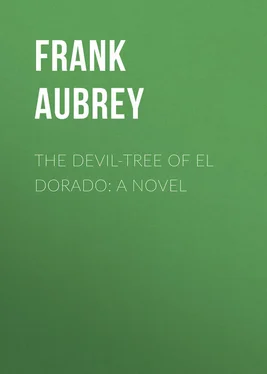Frank Aubrey - The Devil-Tree of El Dorado - A Novel
Здесь есть возможность читать онлайн «Frank Aubrey - The Devil-Tree of El Dorado - A Novel» — ознакомительный отрывок электронной книги совершенно бесплатно, а после прочтения отрывка купить полную версию. В некоторых случаях можно слушать аудио, скачать через торрент в формате fb2 и присутствует краткое содержание. ISBN: , Жанр: foreign_antique, foreign_prose, на английском языке. Описание произведения, (предисловие) а так же отзывы посетителей доступны на портале библиотеки ЛибКат.
- Название:The Devil-Tree of El Dorado: A Novel
- Автор:
- Жанр:
- Год:неизвестен
- ISBN:http://www.gutenberg.org/ebooks/43944
- Рейтинг книги:3 / 5. Голосов: 1
-
Избранное:Добавить в избранное
- Отзывы:
-
Ваша оценка:
- 60
- 1
- 2
- 3
- 4
- 5
The Devil-Tree of El Dorado: A Novel: краткое содержание, описание и аннотация
Предлагаем к чтению аннотацию, описание, краткое содержание или предисловие (зависит от того, что написал сам автор книги «The Devil-Tree of El Dorado: A Novel»). Если вы не нашли необходимую информацию о книге — напишите в комментариях, мы постараемся отыскать её.
The Devil-Tree of El Dorado: A Novel — читать онлайн ознакомительный отрывок
Ниже представлен текст книги, разбитый по страницам. Система сохранения места последней прочитанной страницы, позволяет с удобством читать онлайн бесплатно книгу «The Devil-Tree of El Dorado: A Novel», без необходимости каждый раз заново искать на чём Вы остановились. Поставьте закладку, и сможете в любой момент перейти на страницу, на которой закончили чтение.
Интервал:
Закладка:
Meanwhile, further shots had given the coup de grâce to the three that had been knocked over, and the victors went up to examine them. They seemed to be a kind of panther or leopard of a light grey colour, approaching white in places, with markings of a deeper colour.
Neither Templemore nor Elwood had ever previously seen any animal, or the skin of one, at all like these. They were, moreover, of different shape from either the jaguar or the tiger-cat; larger than the latter, and more thick-set than the former.
“These must be the ‘white jaguars’ that the Indians say help to guard Roraima,” Jack observed, looking in perplexity at the strange creatures.
“Yes,” said Matava, who had now come up, “and they are ‘Warracaba tigers.’” 7 7 A vivid account of an adventure with these formidable animals will be found in Mr. Barrington Brown’s ‘Canoe and Camp Life in British Guiana,’ page 71. Very little is known about them, but they are believed to have their haunts in the unexplored mountain districts, from which they occasionally descend into other parts. Mr. Brown states that the Indians fear them above everything; and, while comparatively brave as regards jaguars and tiger-cats of all kinds, give way to utter panic at the mere idea that ‘Warracaba tigers’ are in their neighbourhood. It is said that nothing stops or frightens them except a broad stream of water – not even fire.
“What on earth are they?” asked Leonard.
“Warracaba tiger,” Monella said, “is the name given to a species of small ‘tiger’ (in America all such animals are called ‘tigers’) that hunts in packs, and is reputed to be unusually ferocious. They have a peculiar trumpeting cry, not unlike the sound made by the Warracaba bird – the ‘trumpet-bird’ – hence their name.”
“They look to me more like light-coloured pumas,” Jack remarked.
“No; pumas are not marked like that, and do not make the sounds we heard. Besides, you need never fear a puma, and should never shoot at one, unless it is attacking your domestic animals.”
Both Templemore and Elwood looked up in surprise.
“I always thought,” the latter said, “that pumas were such bloodthirsty animals.”
“So they are, to other animals – even the jaguar they attack and kill. But men they never touch, if let alone. I do not believe there is a single authenticated instance of a puma’s hurting any human being, man, woman or child. In the Andes and Brazil – where I have lived long enough to know – the Gauchos call the puma ‘Amigo del cristiano’ – ‘the friend of man’ – and they think it an evil thing to kill one.” 8 8 A very interesting account of the South American puma will be found in ‘The Naturalist in La Plata,’ by Mr. W. H. Hudson. He states that the puma has a strange natural liking for, or sympathy with, man; that, though ferocious and bloodthirsty in the extreme as regards other animals, yet it never attacks man, woman, or child, awake or asleep. He quotes many authorities, and gives numerous instances, of a very remarkable character, from the accounts of hunters and others whom he has himself seen and questioned.
A few days after, they were attacked again by these furious creatures, and this time did not come off so well, for two of the Indians were badly mauled. But for Monella’s cool bravery, indeed, matters would have been much worse; and Templemore had a narrow escape. Then, a day or two later, one of the Indians was stung by a scorpion; and Jack came near being bitten by a rattlesnake – would have been but for Monella, who, just in time, boldly seized the reptile by the tail, and, swinging it two or three times round his head, dashed its brains out against a piece of rock.
Indeed, upon all occasions where there was any kind of danger, Monella’s ready, quiet courage was always displayed in a manner that won both the admiration of his white colleagues and the devotion of his Indian followers. Moreover, as Dr. Lorien had stated, and as Leonard had found by actual experience, he was skilled in medicine and surgery. To wounds he applied the leaves of some plant, of which he had a store with him in a dried state, the curative effects of which were reputed among the Indians to be almost marvellous.
But even these incidents were surpassed by a startling experience they had a short time afterwards. On going to their working ground one morning, two or three Indians in advance of the remainder of the party saw, lying across the path, what they took to be the trunk of a tree that had fallen during the night; and they sat upon it, indolently, to wait for the others to come up. Suddenly, one of them sprang up, exclaiming, “It’s alive! I felt it move! It is breathing!” They all jumped up, in alarm, when the great snake – for such it proved to be – glided off into the wood. Most likely the others would have ridiculed their story, but that Templemore happened to come up in time to witness what occurred. And through the underwood, on both sides of the path, was plainly to be seen a sort of small tunnel that marked the place where the serpent had been lying asleep.
Matava and his fellows, of course, insisted that this was the great ‘camoodi,’ that Indian tradition had long declared existed in this forest – set there specially, by the demons of the mountain, to guard it from intrusion.
These constant dangers and adventures made the task of keeping the Indians from deserting doubly difficult, and rendered the work both harassing and tedious to the others. Only Monella showed no weariness, no sign of the strain it all involved; so far from that, these troubles seemed only to increase his vigilance, his power of endurance, and his determination.
And all the time they were cutting their way through vegetation that would have astonished and delighted the heart of a botanical collector such as Dr. Lorien. Not only within the wood, but in the whole district round, unknown and wondrous flowers and plants abounded. But the explorers had neither time nor inclination to take that interest in them they merited, and would, at any other time, have undoubtedly excited. 9 9 See extract given in the preface (page viii .) from Richard Schomburgk’s book ‘Reissen in Britisch Guiana.’
CHAPTER VI
THE MYSTERIOUS CAVERN
When the time drew near for the adventurers, if Monella’s calculations proved correct, to reach the base of the towering rock towards which they were making their way with so much labour, a suppressed excitement became apparent throughout nearly the whole party. It was clearly visible in the Indians and in Elwood; and Templemore, even, showed signs of anxiety. Monella alone was imperturbable as ever, and, if any unusual feeling arose in his mind, there was no trace of it to be seen in his placid manner. Perhaps a close observer might have seen, at times, a little more fire in the gaze of his keen eyes; but it was scarcely noticeable to those around him.
Elwood did not attempt to hide the state of expectancy into which he had gradually worked himself; but while he, on the one hand, grew more excited, Jack Templemore, on the other, became steadily more pessimistic and moody. Since the adventure of the great ‘camoodi’ he seemed nervous and depressed, and he no longer troubled himself to conceal the discontent that now possessed him. The continued sojourn in that terrible forest was becoming too much for his peculiar temperament. Its gloom oppressed him more and more each day; and he had become silent and unsociable, often sitting for long intervals stolidly smoking and, if addressed, replying only in monosyllables. They had now been for some weeks in the wood, camping in it every night, and going back to ‘Monella Lodge’ only for the Sundays. To this rule Monella rigidly adhered; but, since it took the greater part of a day to reach the edge of the forest from the point they had now attained, but little work was done at the path-making on Saturdays, Sundays, or Mondays. Hence their progress had become slower, and Templemore’s discontent and impatience increased in proportion.
Читать дальшеИнтервал:
Закладка:
Похожие книги на «The Devil-Tree of El Dorado: A Novel»
Представляем Вашему вниманию похожие книги на «The Devil-Tree of El Dorado: A Novel» списком для выбора. Мы отобрали схожую по названию и смыслу литературу в надежде предоставить читателям больше вариантов отыскать новые, интересные, ещё непрочитанные произведения.
Обсуждение, отзывы о книге «The Devil-Tree of El Dorado: A Novel» и просто собственные мнения читателей. Оставьте ваши комментарии, напишите, что Вы думаете о произведении, его смысле или главных героях. Укажите что конкретно понравилось, а что нет, и почему Вы так считаете.












